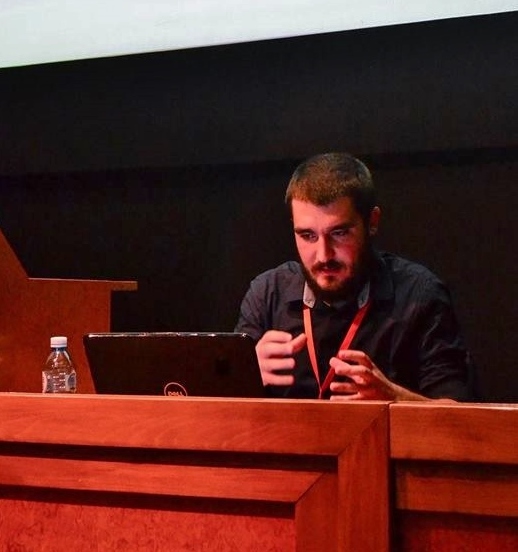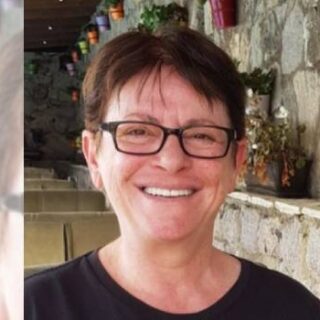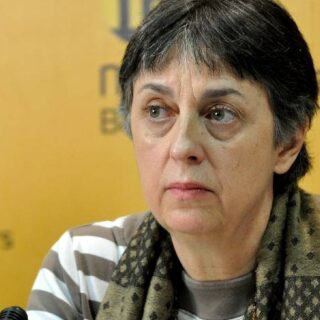Graduate School for Social Research, Polish Academy of Sciences
To better understand the developments in Macedonia on the eve of and during the Yugoslav wars, the reader will benefit from a brief overview of the Macedonian 1980s and, pretty ahistorically, the subsequent decade or the 1990s. Starting from the latter one and the critical turning point of 1991, it is a commonplace that the Republic of Macedonia – today’s North Macedonia, the former southernmost Yugoslav federal state – was the only Yugoslav republic to avoid the armed bloodshed in the 1990s and, as such, was frequently referred to as a “peace-oasis” in the 1990s Balkans. The first pluralist Macedonian parliament – a result of the so-called “Macedonian spring” of the late 1980s and the early 1990s, further discussed below – voted a Declaration for independence in January 1991 before proposing an independence referendum for 8 September 1991. The successful plebiscite – with more than 95% of the voters voting for an independent and sovereign Macedonia (with “a right to join a future union of sovereign Yugoslav states”), the November 1991 Macedonian constitution, the increased presence of the international community in the country as well as the agency of Kiro Gligorov – a WWII veteran, member of the Macedonian wartime provisional government, a long-time high-official in Belgrade and the first president of post-Yugoslav Macedonia – paved the way for an agreement over a peaceful withdraw of the Serbian-dominated Yugoslav army from the Macedonian territories and further democratization of the now sovereign, Macedonian state. The Gligorov-Milošević agreement was concluded in February 1992, while the Yugoslav army retreated in February and March the same year: a critical event for easing the tensions over Macedonia in the course of the Yugoslav wars and dissolution.[1]

However, a set of internal socio-political issues and external affairs – which unarguably marked the Macedonian 1990s – questioned the very existence and the eventual future of the new post-Yugoslav state: inter alia, the univocal media scene, contested privatization, slow-paced tempo of foreign investments and building intra-state ethnic tensions, but also the official Greek refusal to recognize the state’s name Macedonia, the subsequent Greek embargo in 1994, and the emerging crisis in neighboring Kosovo (1995-1999). All these events have seriously shaken the ontological security of the Macedonian citizens in the 1990s. An edited volume by the Foundation Open Society Institute Macedonia – published in 2001 and entitled Macedonia 1989-1999 – provides an interesting perspective on the events as mentioned earlier. Namely, the editors asked the authors – the then most prominent Macedonian politicians, economists and businessmen – the question “[w]hy Macedonian citizens feel unsafe,” and, foreseeably enough, all the articles provided affirmative answers and listed various reasons for this feeling of unsafety.[2] Moreover, the state’s “fragile inter-ethnic balance and delicate political bargaining”.[3] evolved into a seven-month armed conflict in 2001 across ethnic lines: the Macedonian state forces and the ethnic-Albanian insurgents. The insurgency did not turn into a full-fledged civil war and was settled with the so-called Ohrid Framework Treaty – a peace agreement that reimagined the state’s multiethnic identity and further institutionalized ethnic minority rights.
Much of the aforementioned was a result of the Macedonian 1980s. The decade following Tito’s death was a peak point of the state’s “economic underdevelopment”[4] – with a rise of unemployment and foreign and domestic debts – but also a period of deterioration of the state’s interethnic relations. The late 1980s decision to suspend Article 49 of the 1974 Yugoslav Constitution in socialist Macedonia, which defined Macedonia as a nation-state of the Macedonians and a state for the Albanians, Turks and the other nationalities – is one such episode that is often overlooked in the scholarly literature. Here, Slavko Milosavlevski’s oeuvre is of particular significance: a sociology professor and a member of the so-called 1960s and 1970s liberal fraction of the Macedonian League of Communists himself, he was among the first authors who pointed out the inconsistent, conservative, and even nationalistic politics of the Macedonian ruling elites in the 1980s.[5]
The series of events succeeding the 10th Congress of the Macedonian League of Communists should be viewed against this background: parallelly to the fall of the Berlin Wall, the rise of Milošević, and the turmoil in then-neighbouring Romania, the ruling party in socialist Macedonia voted for a change of the so-called “dogmatic” elite and brought a new generation of politicians to power in late 1989, thus critically shifting the political course of the party and the state. What followed was a glasnost-like set of structural reforms which enabled political pluralism (initially within the Macedonian League of Communists, at a state-level as of early 1990), democratic elections (which took place on 11 November 1990 and ended up in December 1990, after three voting rounds, while the first post-Yugoslav, expert, the government was established on 20 March the following year), and an independence referendum (which was voted by the Macedonian parliament with acclamation in August 1991, slightly after the start of the military activities in Yugoslavia).[6]
Antiwar escape routes
The antiwar discourse, activism and politics in the late 1908s and early 1990s Macedonia can be argued to be a predominantly top-down, elite-driven endeavour. Two major trajectories can be identified in these regards. Firstly, it is yet another commonplace that the high-profiled Macedonian politicians sought to negotiate or, perhaps even, to settle the arising nationalistic tensions within the Yugoslav state organs and structures. In chronological order, one can mention the activities of Vasil Tupurkovski – an international law professor and a member of the Yugoslav Presidency in the late 1980s – who, alongside his Bosnian and Herzegovinian counterpart, Bogić Bogićević, “acted as negotiators/arbiters” between the pro-centralization (Serbia, Montenegro) and pro-decentralization (Croatia, Slovenia) camps in the early period of the armed conflicts in Slovenia and Croatia.[7] Tupurkovski was also among the Presidency members who opposed Milošević’s push to disenfranchise this collective decision-making body in March 1991 and gain total control over the Yugoslav army.[8]
Just a few months afterwards, in May 1991, the Macedonian President, Kiro Gligorov, together with Alija Izetbegović, the then chairman of the Presidium of Bosnia and Herzegovina, proposed a project for remodelling Yugoslavia to a group of the so-called “European Twelve” led by the chairman of the European Community Jacques Delors. This initiative came after a series of presidential summits where Gligorov and Izetbegović “held mediating positions.”[9] Based on a 2+2+2 principle, the so-called Gligorov-Izetbegović projected an asymmetric federation as a mean of avoiding a Yugoslav break-up, or in the words of Misha Glenny, “the only solution to the Yugoslav crisis which might have ended peacefully.”[10]
Several authors agree upon the reasons for these steps by the Macedonian politicians and political elites: it was the Yugoslav federation that helped to finalize the Macedonian nation- and state-building in the post-WWII period, sheltered the state in its bilateral quarrels over history and memory, and navigated its complex interethnic relations.[11] Thus, it is not surprising that the Macedonian citizens – of a predominantly Macedonian ethnicity – sough the national (Macedonian) and the supra-national (Yugoslav) identities as complementary in the late 1980s. Ljubica Spaskovska, in her seminal The last Yugoslav generation: The rethinking of youth politics and cultures in late socialism, neatly demonstrates that even though the young Yugoslavs had a “fundamental faith in the Yugoslav project” in the 1980s, it was the Macedonian citizens who had the highest percentage of affirmative answers to the Yugoslav program for research of the youth statement: “The feelings of Yugoslav belonging and my national belonging are not the same, but I care about both of them” (69%, with 61% being the Yugoslav average).[12] In a similar vein, it would be in Macedonia (and Bosnia and Herzegovina) where the “only pan-Yugoslav non-ethnic political option” – the Alliance of Reformist Forces of Yugoslavia led by the last Yugoslav Prime Minister Ante Marković – won a considerable number of votes in 1990.[13]
A similar set of developments can be identified in – what can be roughly defined as – the embryonic civil society in post-Yugoslav Macedonia. Ana Devic, for instance, notes the formation of the so-called “Macedonian Forum for Freedom of Information and Democracy” in Skopje, in 1991, by a group sympathetic to Marković’s party and Gligorov, as a “a discussion and meeting centre of the non-nationalist intellectuals.” She also listed the weekly Puls, alongside the Forum, as yet another platform which gathered a younger group of public intellectuals at one place, that, in turn, were able to “elaborate and promote legal coordinates for multiethnic Macedonia, focusing on the critique of the Macedonian nationalists parties’ attempts to obstruct the cultural autonomy of the Macedonian Albanian population.”[14]
The first democratic elections and the platforms above are also illustrative for the second trajectory: the attempts to avoid a civil war in Macedonia across ethnic and religious lines. The early 1990s clash “over the basic idea behind the concept of the state” between the Macedonian and Albanian elites materialized into a boycott of the constitution voting and census taking by the Macedonian Albanians,[15] while it culminated during the 1990 episodes of political campaigning when the nationalistic tensions rose to the limits of armed confrontations. Again, it would be the elites’ agency and the socialist legacies of political representation – alongside the international community presence in the state – which helped to overcome the building tensions in the early 1990s: even though representatives of the “ethnic minorities” took part in the working groups drafting the constitution, the census and several of the most contested laws,[16] the ethnic Albanian Party for Democratic Prosperity decision to participate in the governing coalition in 1992 was the “key for Republic of Macedonia’s stability” and thus legitimized the first political government in its democratic history.[17]
The aftermath
What are the dominant public narratives over the Macedonian late 1980s and early 1990s today? A brief exploration of the commemorative discourses and activities will reveal the prevailing tendencies and propose an eventual research agenda. On the one hand, although 8 September is massively celebrated as a state holiday in post-Yugoslav Macedonia, it remained a holiday that is almost exclusively commemorated within the ethnic Macedonian camp as of the early 1990s: mostly as a mean of re-legitimizing the ethnic Macedonian identity.[18] Even though the last pre-pandemic state-commemoration in 2019 was marked by the attempt to shift the commemorative paradigm over 8 September – the main event was organized at the open stage “Seashell” in the Skopje city park (a “seashell-opening” metaphor was also used to highlight the transethnic character of the event), under the slogan (in plural!) “The colours of the independence” – yet, the 2020 addresses on the occasion of 8 September reaffirmed the dominant, post-2001 political narratives over 8 September: the independence referendum results are represented as a significant benchmark in the history of Macedonian nation- and state-building, while the reasons for the boycott of the plebiscite are almost entirely overlooked, as well as the general pre- and post-referendum atmosphere.
On the other hand, a wider – and more inclusive – commemorative stance over the Macedonian late 1980s and early 1990s is being recently pushed by various other formal and informal stakeholders. Worth mentioning here is the series of interviews with various stakeholders active during the independence referendum, conducted by the online platform Sakam da kažam in the mid-2010s.[19] Such type of interviews not only assist in democratizing the public discourse over 8 September and the early years of the Macedonian sovereignty but also contribute to a deelitization of the discourse over the Yugoslav antiwar activism in toto – with the “elite-oriented accounts” being one of the major reasons for the marginalization of the antiwar activism in the recent scholarship on the Yugoslav wars.[20] Some preliminary results are already visible: the recent commemorations of Šaško Gešovski – a 19 years old Macedonian, the first victim of the Yugoslav wars and one of the 54 Macedonians who died as Yugoslav army’s conscripts in the 1990s[21] – but also the increased media presence of the name of Dragoljub Bocinov – a Macedonian-born general of the Yugoslav army who spent 18 months in prison for his refusal to bomb Split and the first Chief of the General Staff of the Macedonian Army.[22] These commemorative events, in turn, provide platforms for discussing- and a better understanding of the complex dynamism of the antiwar discourses and practices in Macedonia’s late 1980s and early 1990s.
Naum Trajanovski is a PhD candidate in Sociology at the Graduate School for Social Research at the Institute of Philosophy and Sociology of the Polish Academy of Sciences. He was a project co-coordinator at the European Network Remembrance and Solidarity (2017), and a researcher at the Faculty of Philosophy, Ss. Cyril and Methodius University, Skopje (2018-2020). His major academic interests include the memory politics in North Macedonia, and the sociological knowledge transfer in the 1960s in Eastern Europe. He is the author of a book in Macedonian titled Operacija Muzej: Muzejot na makedonskata borba i makedonskata politika na sekjavanje (Operation Museum: The Museum of the Macedonian Struggle and the Macedonian Memory Politics; Skopje: Templum, 2020).
[1] Gligorov mentions two interesting episodes from late 1990 in his memoir: there was an organized attempt to attack the headquarters of the Yugoslav army in Skopje by a group of rightist political supporters, which was, according to Gligorov, stopped by his cabinet in the very last moment; Gligorov was also afraid of a military putsch in the course of the Yugoslav army’s withdraw from Macedonia so, at one critical point, he recorded a personal interview – which was supposed to be aired only in case of his arrest – where he called the Macedonian citizens for nonviolent, peaceful resistance against the putschists. More in Kiro Gligorov, Makedonija e sè što imame (Skopje: Kultura, 2002), 189-190.
[2] More in Fani Karanfilova-Panovska (ed.), Makedonija 1989-1999 (Skopje: Institut otvoreno opštestvo, 2001).
[3] Ljubica Spaskovska, “Macedonia’s Nationals, Minorities and Refugees in the Post-Communist Labyrinths of Citizenship,” University of Edinburgh Working Paper Series (2010/05), 2.
[4] Ljubica Jančeva and Aleksandar Litovski, “Macedonia and Macedonians in Yugoslavia” in Yugoslavia from a Historical Perspective, ed. Latinka Perović et al. (Belgrade: Helsinki Committee for Human Rights in Serbia, 2017), 179-180. See, as well, Misha Glenny, “The Macedonian Question” in International Perspectives on the Yugoslav Conflict, eds. Alex Danchev and Thomas Halverson (London – New York: Macmillan – St. Martin’s Press, 1996), 134-147.
[5] See his monographs Dvete lica na sobitijata (Skopje: Zumpres, 1996); Istočna Evropa pomeǵu egalitarizmot i demokratijata (Skopje: IP Ljuboten, 1993), 133-179; and Makedonski kontroverzi 1990-2003 (Skopje: IP Ljuboten, 2004), 9-98. See, as well, the edited volume of his (co-edited with Mirče Tomovski), entitled Albancite vo Republika Makedonija 1945-1995: Legislativa, politička dokumentacija, statistika (Skopje: NIP Studentski zbor, 1997).
[6] More on the timeline of the Macedonian 1989-1991 in Katerina Blaževska, “Deset godini makedonski pluralizam” in Makedonija 1989-1999, ed. Fani Karanfilova-Panovska (Skopje: Institut otvoreno opštestvo, 2001), 121-132.
[7] More in Ljubica Spaskovska, “Landscapes of Resistance, Hope and Loss: Yugoslav Supra-Nationalism and Anti-Nationalism” in Resisting the Evil: [Post-]Yugoslav Anti-War Contention, eds. Bojan Bilic and Vesna Jankovic (Baden-Baden: Nomos, 2012), 37-62.
[8] Blaine Harden, “Yugoslav Political Turmoil Broadens,” The Washington Post, March 19, 1991.
[9] Spaskovska, “Landscapes of Resistance,” 46.
[10] Misha Glenny, The Fall of Yugoslavia: The Third Balkan War (London – New York: Penguin Books, 1992), 153. Also see: Vera Katz, “A Platform on the Future Yugoslav Community (Izetbegovic-Gligorov Plan): A View from the Perspective of Bosnia and Herzegovina,” Politeja 30:4 (2014): 191-210; and Adrianne Rubeli, “Threats to Sovereignty: The Case of Macedonia in the 1990’s” in A Captured Moment in Time, eds. Adrianne Rubeli and Nina Vucenik (Vienna: IWM, 2000), 1-15.
[11] For an overview, see Naum Trajanovski, Operacijata Muzej: Muzejot na makedonskata borba i makedonskata politika na seḱavanje (Skopje: Templum, 2020).
[12] Ljubica Spaskovska, The last Yugoslav generation: The rethinking of youth politics and cultures in late socialism (Manchester: Manchester University Press), 92-97.
[13] Spaskovska, “Landscapes of Resistance,” 46.
[14] Ana Devic, “Anti-War Initiatives and the Un-Making of Civic Identities in the Former Yugoslav Republics,” Journal of Historical Sociology 10:2 (1997), 138.
[15] Zhidas Daskalovski, “Democratic consolidation and the ‘stateness’ problem: The case of Macedonia,” Global Review of Ethnopolitics 3:2 (2004), 52.
[16] Gale Stokes also mentions that Macedonia was the only post-communist Eastern European state with a multiethnic cabinet by the end of 1992 in his The Walls Came Tumbling Down: The Collapse of Communism in Eastern Europe (Oxford – New York: Oxford University Press, 1993), 252.
[17] Teuta Arifi, “Bezbednosta na zborot” in Makedonija 1989-1999, ed. Fani Karanfilova-Panovska (Skopje: Institut otvoreno opštestvo, 2001), 137-143.
[18] Moreover, in 2014, Aida A. Hozić observed that the lack of commemorative narratives over the Yugoslav dissolution in Macedonia – compared to the commemorations of the global 1989 in Central and Eastern Europe – is closely related to the lack of a clear-cut communist/post-communist regime change in Macedonia. More in her chapter “It Happened Elsewhere: Remembering 1989 in the Former Yugoslavia” in Twenty Years After Communism: The Politics of Memory and Commemoration, eds. Michael Bernhard and Jan Kubik (Oxford – New York: Oxford University Press, 2014), 149-151.
[19] The project, entitled 25 years of independence, showcased interviews with, inter alia, the organizers of the post-referendum ceremony, the Macedonian politicians of Albanian ethnicity and the first coordinator
[20] More in Bojan Bilić, “(Post-)Yugoslav Anti-War Engagement: A Research Topic Awaiting Attention,” Filozofija i Društvo 4 (2011), 83-84.
[21] Sinisa Jakov Marusic, “North Macedonia Commemorates Soldiers Killed in Yugoslav Wars,” BalkanInsight, November 15, 2019.
[22] See, for instance, “Trenerot na MZT Skopje Nazor go poseti grobot na general Bocinov,” Sloboden Pečat, May 25, 2017.




